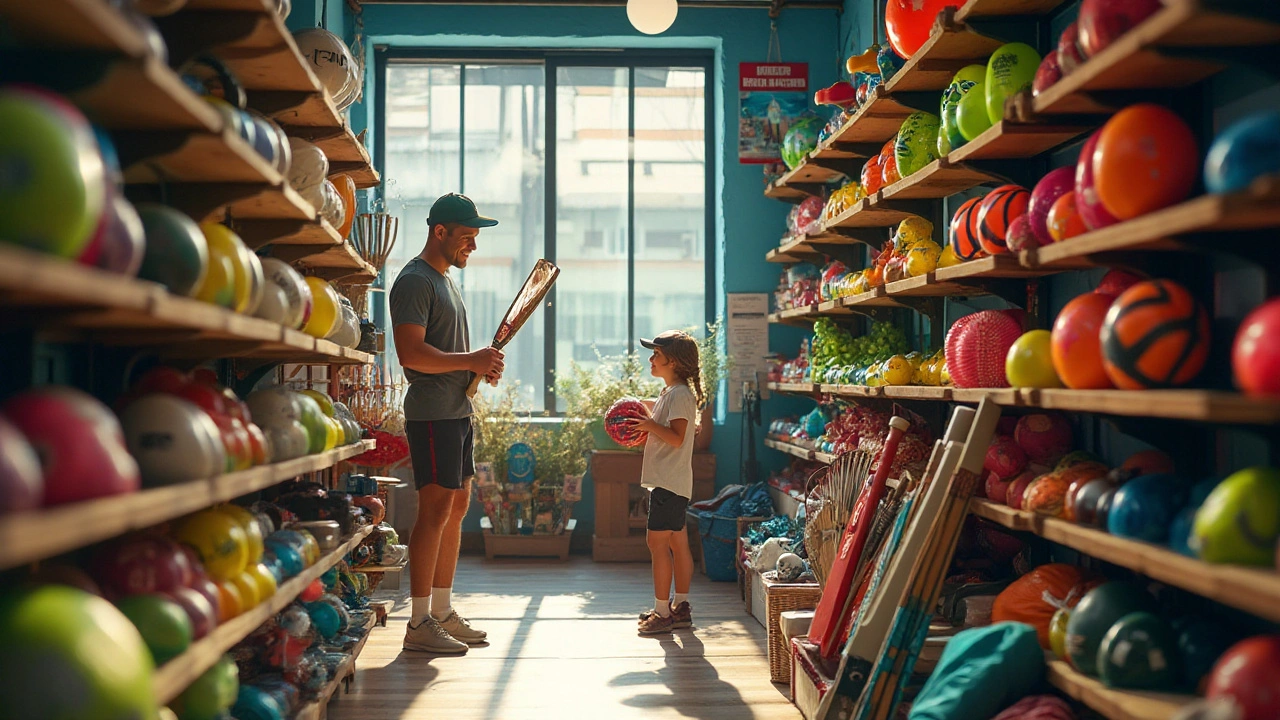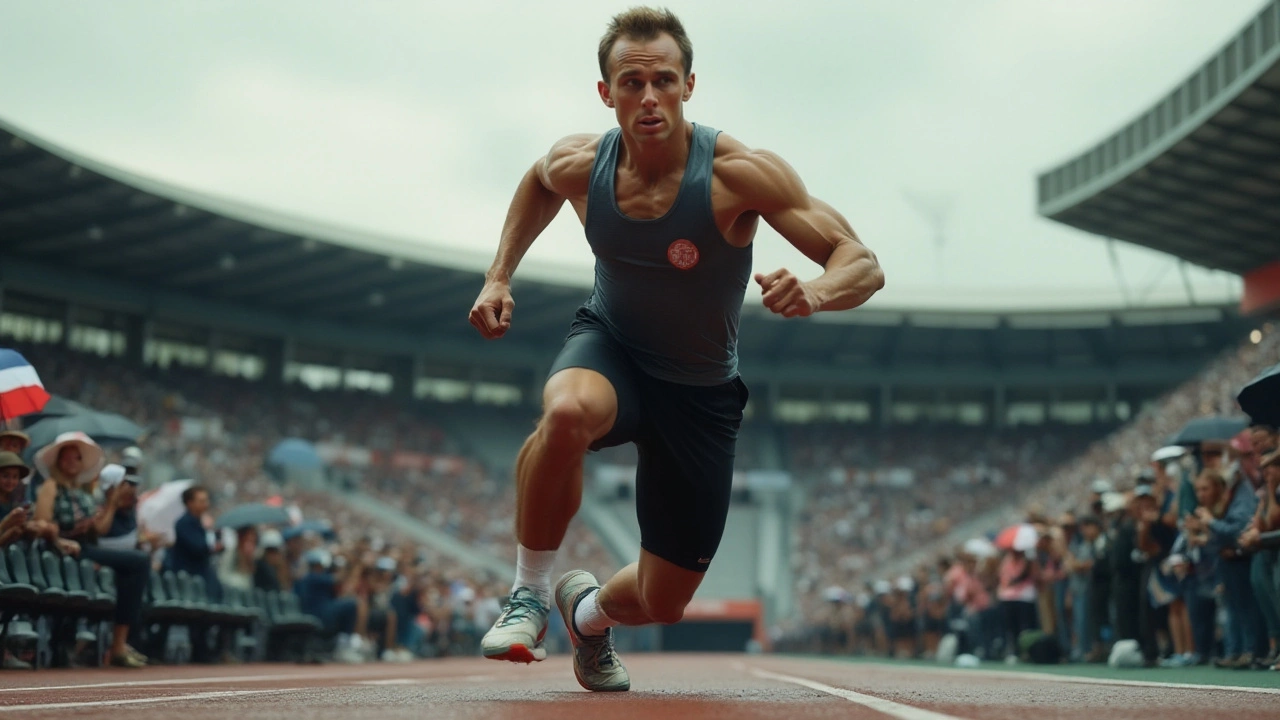Essential Sports Equipment for Every Athlete

Sports today are more than just a pastime or a mode of entertainment. They're a blend of passion, skill, and the right equipment. Without the necessary gear, even the most talented athlete can't perform at their best. Whether you're stepping onto a football pitch, gliding on ice, or taking a swing in tennis, having the proper equipment is indispensable.
But what exactly constitutes 'sports equipment'? Is it just a soccer ball for football or a tennis racket for tennis? The answer is far more diverse. From the shoes on your feet to the protective gear ensuring your safety, sports equipment varies widely based on the sport and level of play. This article explores the essential items every athlete should know about, offering insights and practical tips to guide your sporting journey.
- Basic Sports Gear
- Protective Equipment
- Sport-Specific Items
- Maintenance and Care
- Buying Tips and Recommendations
Basic Sports Gear
When you think about stepping into the world of sports, the first thing that comes to mind is the basic gear essential for participation. Sports gear covers a plethora of items, from the humble pair of trainers to the advanced gear used by professionals. At the crux of it, basic sports gear serves three primary purposes: enhancing performance, ensuring safety, and providing comfort. The very nature of a sport dictates what you wear and use on the field or court, but some items are universally recognized. Athletic essentials form the backbone of any sport, laying the foundation for skill development and passion.
Training shoes or sneakers are a prime example. Whether running, jumping, or sidestepping, the right pair of shoes supports your performance and prevents injuries. These aren't just ordinary shoes; they are designed with a focus on cushioning, stability, and breathability. New designs even come with smart technology that monitors your stride and provides feedback! In the words of Bill Bowerman, the legendary co-founder of Nike, "If you have a body, you are an athlete." This motto underscores the idea that good gear isn't just for professionals, but for every individual who wishes to excel in their sport.
Another critical component of sports gear is clothing. For instance, breathable fabric is more than just a comfort feature. It actively manages body temperature and wicks moisture away, improving endurance. Many athletes prefer clothes made from synthetic fibers like polyester blends due to their durability and quick-drying features. In sports like cycling or swimming, aerodynamic clothing can even shave off precious milliseconds. Layers can offer adaptability in fluctuating weather, proving crucial in prolonged outdoor activities. It's fascinating how simple clothing can impact training and competition.
Accessories shouldn't be overlooked. They're not just about style but serve functional purposes. For basketball players, skin-tight arm sleeves enhance circulation and reduce fatigue. For football, shin guards are mandatory to protect against impacts. Each sport has its unique set of must-have items, but all serve to protect and optimize performance. The importance of athlete equipment really becomes apparent when seen in action. Traditional items like golf clubs and basketballs may be obvious, but the meticulous standards that govern their creation are impressive. Size, weight, material—all closely monitored to aid maximum performance.
Regarding safety, the old adage 'prevention is better than cure' is especially relevant. While no one likes to think about accidents, the right gear significantly reduces the chances of injury. Helmets, for example, are lifesavers in contact sports, absorbing impact forces that could otherwise result in severe injuries. Mouthguards, knee pads, and wrist guards also play vital roles in various sports. These items may seem trivial until you realize their protective benefits. Even something as simple as a headband can stave off distractions and enhance concentration.
Understanding what goes into basic sports gear can enhance your appreciation for these items. Modern gear manufacturers not only use advanced materials but often collaborate with athletes to innovate designs that revolutionize sports. Whether you're an amateur just starting out or an experienced athlete eyeing new challenges, having the right equipment will ensure you stay at the top of your game. It's all about marrying utility with innovation to produce something truly beneficial for athletes everywhere. As you explore what works best for you, remember that quality should never be compromised for quantity. So, gear up and get ready to transform your sporting experience.
Protective Equipment
When it comes to sports, the thrill of the game is often accompanied by risks. This is where protective equipment comes into play, serving as the unsung hero that ensures athletes can perform safely. Protective gear varies significantly across sports but universally serves the critical function of preventing injuries, allowing athletes to pursue their passions with fewer worries. From the sturdy helmet to the humble mouthguard, each piece of equipment plays a pivotal role in an athlete's arsenal, contributing to both safety and performance.
The helmet is perhaps the most recognizable piece of sports gear. Used in a variety of sports such as cycling, American football, and cricket, helmets are designed to absorb impact, potentially saving athletes from serious head injuries. In cricket, for example, helmets have significantly reduced the incidence of severe injuries from fast-moving balls—a testament to how effective protective equipment can be. Similarly, in sports like hockey and baseball, helmets are non-negotiable due to the high-speed nature of the games and the potential for flying objects.
Let's not forget about other vital pieces of protective gear like padding and guards. Shin guards are indispensable in football, reducing the risk of fractures and bruises to the lower legs. In basketball, knee and elbow pads protect players during the high-contact moments of aggressive gameplay. Shoulder pads in traditions like rugby and American football are designed to disperse the energy from direct collisions, safeguarding bones and tissues from damage. According to a study by the National Athletic Trainers’ Association, including adequate padding can significantly lower the injury rates for high-contact sports.
The significance of these items extends beyond physical safety. They can have a psychological impact too, freeing athletes to focus on their performance rather than their vulnerabilities. A confident athlete is often a more competent one. As legendary American football coach Vince Lombardi said, "The greatest accomplishment is not in never falling, but in rising again after you fall." This aligns with the notion that by donning the necessary protective equipment, athletes give themselves the peace of mind to rise back and perform after setbacks.
An equally essential yet often overlooked part of protective equipment is the simple mouthguard. Crucial in contact sports like boxing and martial arts, mouthguards help prevent dental injuries and concussions. It's worth noting that wearing mouthguards has been shown to significantly reduce the risk of orofacial injuries in sports, which is why they're recommended across sports platforms globally. In fact, the Academy for Sports Dentistry strongly supports the use of custom-fitted mouthguards to enhance safety.
While the effectiveness of protective equipment is undeniable, maintaining these items is just as important. Regular checks and proper care are key to ensuring their longevity and performance. Many sports enthusiasts might not realize that wear and tear can compromise the safety features of their gear. Therefore, it’s crucial to inspect helmets for cracks and padding for wear before every use. Athletes should also be aware that protective equipment advancements continue to evolve, integrating new materials and designs to enhance safety. By keeping up-to-date with these advancements, athletes can ensure they're benefiting from the latest in protective technology.

Sport-Specific Items
When it comes to sports, the magic often lies in the details—or more precisely, in the gear. While some items are ubiquitous, like sports gear for general fitness, others are tailored specifically to the needs of particular sports. This specificity not only enhances performance but also ensures the safety and comfort of athletes. For instance, in the realm of football, a goalkeeper's gloves are essential; they're crafted meticulously to aid grip and provide protection against fast-paced balls. Without the right gloves, even the most skilled goalkeepers might find themselves at a disadvantage.
Consider tennis, where the significance of a well-chosen racket cannot be overstated. Different rackets cater to styles of play—some offer enhanced power, others provide control, and some are designed to deliver a comfortable feel. For aspiring tennis players, understanding the nuances of their racket's string tension and balance can make a notable difference. Indeed, it's a sports cliché reiterated by pros like Rafael Nadal, who once remarked, "The right racket becomes part of you, guiding each stroke with precision."
Citing a quote or statistic reinforces the critical choices athletes make in their equipment.
Other sports present even more unique requirements. Take hockey, where skates, sticks, and pads are essential components. The sticks vary in flex, height, and curve of the blade—all impacting the player's control and speed. Similarly, ice skates are engineered for stability and swiftness, reflecting the fast-paced nature of the game. Tailoring choices to one's position and play style is paramount, ensuring the athlete's performance is optimal. Additionally, don't forget about protective padding; its meticulous design helps minimize injury risk in this high-contact sport.
For athletes engaged in swimming, the list of must-haves includes not just swimsuits but high-tech gadgets. Modern competitive swimmers often use specially designed suits that reduce drag in the water. Meanwhile, technological advancements have introduced waterproof MP3 players and fitness trackers that keep record of lap counts and heart rate—a boon for swimmer athletes aiming to fine-tune their training regimes. Some top-tier swimmers bank on tools like resistance bands and snorkels to hone their skills outside the pool, adding an extra layer to their arsenal.
And let's not forget athletics, where special gear includes everything from spikes tailored for different track surfaces to aerodynamic clothing designs that slice through air resistance. Modern sprinters and marathon runners often rely on shoes that mix art and science—lightweight yet cushioned, giving that extra leverage to cross finish lines faster. An athletics competition might witness unprecedented feats, but behind each of these achievements is gear meticulously chosen for its sport-specific attributes. Athletic essentials dominate in this classic field.
Whether focusing on enhancing personal performance or staying safe from injury, understanding and adapting these sport-specific equipment items can unequivocally propel athletes towards success. Choosing wisely can often mean the difference between a good match and a great one, supporting both the amateur and professional in their respective athletic quests. The wide-ranging choices signify a pivotal intersection where passion meets purpose through the conduit of significant and essential equipment.
Maintenance and Care
Keeping your sports gear in top-notch condition is as important as selecting the right equipment. Well-maintained equipment not only ensures safety and performance but also extends the life of your investment. Regardless of whether you’re a weekend warrior or a professional athlete, understanding how to care for your gear is critical. A common mistake athletes make is storing their equipment in damp or dusty environments. Humidity and dust can degrade materials, reducing their effectiveness. For instance, storing a tennis racket in a damp place might affect the string tension, impacting your game significantly. It’s essential to find a cool, dry place to store your gear after use.
Cleaning is another vital aspect of maintaining sports equipment. After a rigorous session, you might notice sweat and dirt accumulation, which can lead to unpleasant odors and bacterial growth. For items like helmets, gentle cleaning with mild soap and water can prevent this issue. Meanwhile, sportswear should be washed regularly according to the fabric's care instructions. When it comes to cleaning, a small amount of effort can go a long way in maintaining hygiene and extending the lifetime of your gear. Some seasoned athletes suggest creating a cleaning schedule to ensure no item gets neglected.
"Maintaining your sports equipment is like maintaining your body, it ensures peak performance and prevents breakdowns," says renowned sports coach Emma Hamilton.
Occasional inspections are crucial for preventing sudden equipment failures. Look for wear and tear, especially in high-stress areas like the hinges on protective helmets or the soles of athletic shoes. Some items might need professional servicing, such as the calibration of a golf club or restringing a squash racket. Knowing when to seek professional help can save both time and money in the long run. Don't shy away from consulting a specialist if you think your equipment needs more than just a simple tweak.
Ultimately, balancing between the use and maintenance of your equipment requires discipline. Consider scheduling time each month to perform comprehensive checks. And, don’t forget the little things such as tightening screws on bicycles or lubing up the bearings on roller skates. Engaging in regular maintenance keeps you attuned to the subtleties of your athletic essentials, empowering you to optimize every aspect of your sporting pursuit.

Buying Tips and Recommendations
When it comes to purchasing sports gear, the options can often seem endless, and making the right choice can be quite overwhelming. One key rule is to understand your personal needs and preferences. Are you a casual player looking for basic functionality, or are you a professional in search of the latest high-tech advancements? Knowing what you need before you step into a store can save you both time and unnecessary expenditure. Brand name isn't always everything, but reputation can give you a good indication of quality, especially when you're just starting. Consider reading reviews from fellow athletes who have similar needs to yours. These reviews often highlight not only the product features but also its durability and performance in the field.
"Investing in quality equipment diminishes the risk of injuries and enhances performance," says sports technology expert Dr. Jane Ternbridge.
Purchasing the right athlete equipment also demands a keen eye for comfort and fit, especially for items like footwear and apparel. Fit is crucial when it comes to maximizing performance and preventing injury. When trying on shoes, for example, never rush the process. Make sure there's enough room in the toe box, and check the heel grip. Walk, run a few steps, or simulate your sport’s movements if possible to ensure they match up with your physical activity. Apparel should allow for free movement without excess material that could hinder performance or get in the way. This might mean spending a bit more time in fitting rooms, but your comfort will pay off in the long run.
It's also wise to purchase sports items in person whenever possible. This way, you can physically assess several options, compare them side by side, and benefit from any in-store advisement. While online shopping offers convenience and often competitive pricing, never underestimate the power of tactile feedback. Feeling the grip of a racket, or the weight of a helmet can make all the difference in your buying decision. For those who prefer online shopping, make sure to choose platforms with clear return policies, so you can exchange gear that doesn't meet your expectations.
Another tip is to pay attention to seasonal sales which can offer significant savings on high-quality equipment. Retailers often clear out inventory at the end of a season, so be on the lookout for these sales to get the best bang for your buck. Additionally, if possible, try to bundle purchases, as many sports stores offer discounts on sets or multiple-item buys. Loyalty programs might also come in handy for regular buyers, providing deals and early access to new releases or sales.
Below is a simple comparison of average costs for basic sports equipment across some popular sports:
| Sport | Item | Average Cost (£) |
|---|---|---|
| Football | Football Boots | 50-200 |
| Tennis | Tennis Racket | 70-250 |
| Running | Running Shoes | 60-150 |
By taking the time to research and plan your purchases, you'll not only invest in the right athletic essentials that meet your needs but also make informed decisions that balance performance with price. Happy shopping and may your new gear lead to personal bests and unforgettable sporting moments!
